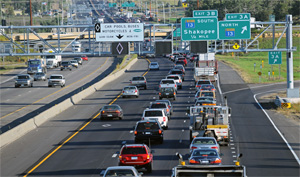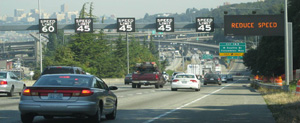Active Traffic Management
Definition

Source – Minnesota DOT

Source – Washington State DOT
Active traffic management (ATM) is the ability to dynamically manage recurrent and non-recurrent congestion based on prevailing and predicted traffic conditions. Focusing on trip reliability, it maximizes the effectiveness and efficiency of the facility. It increases throughput and safety through the use of integrated systems with new technology, including the automation of dynamic deployment to optimize performance quickly and without delay that occurs when operators must deploy operational strategies manually. ATM approaches focus on influencing travel behavior with respect to lane/facility choices and operations. ATM strategies can be deployed singularly to address a specific need such as the utilizing adaptive ramp metering to control traffic flow or can be combined to meet system-wide needs of congestion management, traveler information, and safety resulting in synergistic performance gains.
Examples of Strategies
- Adaptive Ramp Metering: This strategy consists of deploying traffic signal(s) on ramps to dynamically control the rate vehicles enter a freeway facility. This in essence smoothes the flow of traffic onto the mainline, allowing efficient use of existing freeway capacity. Adaptive ramp metering utilizes traffic responsive or adaptive algorithms (as opposed to pre-timed or fixed time rates) that can optimize either local or system-wide conditions. Adaptive ramp metering can also utilize advanced metering technologies such as dynamic bottleneck identification, automated incident detection, and integration with adjacent arterial traffic signal operations. In an ATDM approach, real-time and anticipated traffic volumes on the freeway facility will be used to control the rate of vehicles entering the freeway facility. Based on the conditions, the ramp meter rates will be adjusted dynamically.
- Adaptive Traffic Signal Control: This strategy continuously monitors arterial traffic conditions and the queuing at intersections and dynamically adjusts the signal timing to optimize one or more operational objectives (such as minimize overall delays). Adaptive Traffic Signal Control approaches typically monitor traffic flows upstream of signalized locations or segments with traffic signals, anticipating volumes and flow rates in advance of reaching the first signal, then continuously adjusting timing parameters (e.g., phase length, offset, cycle length) during each cycle to optimize operational objectives.
- Dynamic Junction Control: This strategy consists of dynamically allocating lane access on mainline and ramp lanes in interchange areas where high traffic volumes are present and the relative demand on the mainline and ramps change throughout the day. For off-ramp locations, this may consist of assigning lanes dynamically either for through movements, shared through-exit movements, or exit-only. For on-ramp locations, this may involve a dynamic lane reduction on the mainline upstream of a high volume entrance ramp, or might involve extended use of a shoulder lane as an acceleration lane for a two-lane entrance ramp which culminates in a lane drop. In an ATDM approach, the volumes on the mainline lanes and ramps are continuously monitored and lane access will be dynamically changed based on the real-time and anticipated conditions.
- Dynamic Lane Reversal or Contraflow Lane Reversal: This strategy consists of the reversal of lanes in order to dynamically allocate the capacity of congested roads, thereby allowing capacity to better match traffic demand throughout the day. In an ATDM approach, based on the real-time traffic conditions, the lane directionality is updated quickly and automatically in response to or in advance of anticipated traffic conditions.
- Dynamic Lane Use Control: This strategy involves dynamically closing or opening of individual traffic lanes as warranted and providing advance warning of the closure(s) (through the use of Lane-Use Control Signals), in order to safely merge traffic into adjoining lanes. In an ATDM approach, as the network is continuously monitored, real-time incident and congestion data is used to control the lane use ahead of the lane closure(s) and dynamically manage the location to reduce rear-end and other secondary crashes.
- Dynamic Merge Control: This strategy (also known as dynamic late merge or dynamic early merge) consists of dynamically managing the entry of vehicles into merge areas with a series of advisory messages (e.g., displayed on a dynamic message sign [DMS] or lane control sign) approaching the merge point that prepare motorists for an upcoming merge and encouraging or directing a consistent merging behavior. Applied conditionally during congested (or near congested) conditions, dynamic merge control can help create or maintain safe merging gaps and reduce shockwaves upstream of merge points. In an ATDM approach, conditions on the mainline lanes and ramps approaching merge areas are continuously monitored and the dynamic merge system will be activated dynamically based on real-time and anticipated congestion conditions.
- Dynamic Speed Limits: This strategy adjusts speed limits based on real-time traffic, roadway, and/or weather conditions. Dynamic speed limits can either be enforceable (regulatory) speed limits or recommended speed advisories, and they can be applied to an entire roadway segment or individual lanes. In an ATDM approach, real-time and anticipated traffic conditions are used to adjust the speed limits dynamically to meet an agency’s goals/objectives for safety, mobility, or environmental impacts.
- Part-Time Shoulder Use: This strategy enables the use of the shoulder as a travel lane(s), known as Hard Shoulder Running (HSR) or temporary shoulder use, based on congestion levels during peak periods and in response to incidents or other conditions as warranted during non-peak periods. In contrast to a static time-of-day schedule for using a shoulder lane, an ATDM approach continuously monitors conditions and uses real-time and anticipated congestion levels to determine the need for using a shoulder lane as a regular or special purpose travel lane (e.g., transit only).
- Queue Warning: This strategy involves real-time displays of warning messages (typically on dynamic message signs and possibly coupled with flashing lights) along a roadway to alert motorists that queues or significant slowdowns are ahead, thus reducing rear-end crashes and improving safety. In an ATDM approach, as the traffic conditions are monitored continuously, the warning messages are dynamic based on the location and severity of the queues and slowdowns.
- Transit Signal Priority: This strategy manages traffic signals by using sensors or probe vehicle technology to detect when a bus nears a signal controlled intersection, turning the traffic signals to green sooner or extending the green phase, thereby allowing the bus to pass through more quickly. In an ATDM approach, current and predicted traffic congestion, multi-agency bus schedule adherence information, and number of passengers affected, may all be considered to determine conditionally if, where, and when transit signal priority may be applied.
Throughput Maximization Example
Former Washington State Transportation Secretary, Doug MacDonald demonstrates throughput maximization by pouring rice into funnels at different paces. The video also introduces dynamic pricing to control freeway supply and demand.
| Project | Location(s) | ATM Strategy(ies) | Active Technologies |
|---|---|---|---|
| Weather-Responsive Speed Limits | Mobile County, AL / Flagstaff, AZ / Portland, ME / Truckee River, NV / Pittsburgh, PA / Knoxville, TN / Cheyenne, WY | Dynamic Speed Limits | Traffic management center (TMC) control, variable speed limit signs, atmospheric sensors, visibility sensors, pavement conditions sensors, dynamic message signs |
| Adaptive ramp metering | Los Angeles, CA / Minneapolis, MN / Portland, OR / Houston, TX | Adaptive ramp metering | Roadway sensors, ramp meter signals, TMC algorithms, TMC control |
| I-66 Active Traffic Management System | Northern VA | Dynamic lane use control, dynamic speed limits, hard shoulder running, merge control, queue warning | Roadway sensors, lane control/dynamic speed limit signals, dynamic message signs, TMC algorithms and control |
| I-70 West Rolling Speed Harmonization | Silverthorne, CO | Dynamic speed limits | Roadway sensors, ramp meters, law enforcement control |
| I-55 Bus-on-Shoulder Demonstration | Chicago, IL | Hard shoulder running, temporary shoulder use | Roadway sensors, dynamic message signs |
| Variable Speed Limits on I-270 | St. Louis, MO | Dynamic speed limits | Roadway sensors, dynamic message signs, dynamic speed limit signals, TMC algorithms and control |
| Midtown in Motion | Manhattan, NY | Adaptive Traffic Signal Control | Roadway sensors, dynamic message signs, TMC algorithms and control |
| US 36 Express Lanes Project | Denver to Boulder, CO | Dynamic messaging signs, HOV/HOT/BRT Express Lanes, Commuter Bikeway | Dynamic tolling, traveler information system, incident management system |
| I-80 Integrated Corridor Mobility (ICM) Project | Bay Area (Carquinez Bridge to Bay Bridge), CA | Adaptive Ramp Metering, HOV ramp metering bypass lanes, VSL and managed lanes, coordinated local street traffic signal timing, bus priority, traveler info | Ramp meters, traffic signal timing, VSL and lane use signals, VMS/traveler info, CCTVs, road sensors, Caltrans Traffic Management Center |
